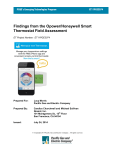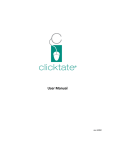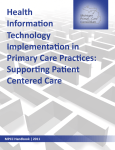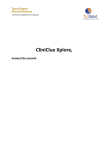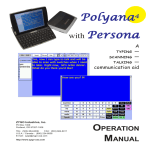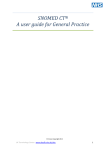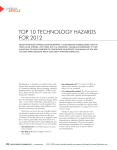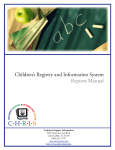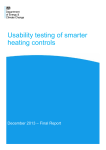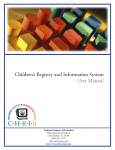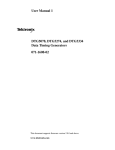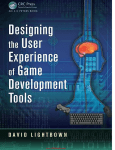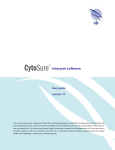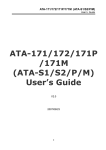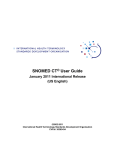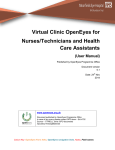Download EHR Final Test Report
Transcript
Test Results Summary for 2014 Edition EHR Certification Version EHR-Test-144 Rev 01-Jun-2015 ONC HIT Certification Program Test Results Summary for 2014 Edition EHR Certification Part 1: Product and Developer Information 1.1 Certified Product Information Product Name: DoctorsPartner EHR/PM Product Version: Version 6.1 Domain: Ambulatory Test Type: Complete EHR 1.2 Developer/Vendor Information Developer/Vendor Name: DoctorsPartner LLC Address: 948 S Wickham Rd, Suite 102 W Melbourne FL 32904 Website: www.emr-electronicmedicalrecords.com Email: [email protected] Phone: 321-574-5245 Developer/Vendor Contact: Naveen Venkatachalam Page 1 of 12 Test Results Summary for 2014 Edition EHR Certification Version EHR-Test-144 Rev 01-Jun-2015 Part 2: ONC-Authorized Certification Body Information 2.1 ONC-Authorized Certification Body Information ONC-ACB Name: Drummond Group Address: 13359 North Hwy 183, Ste B-406-238, Austin, TX 78750 Website: www.drummondgroup.com Email: [email protected] Phone: 817-294-7339 ONC-ACB Contact: Bill Smith This test results summary is approved for public release by the following ONC-Authorized Certification Body Representative: Bill Smith ONC-ACB Authorized Representative Signature and Date Certification Body Manager Function/Title 6/28/2015 2.2 Gap Certification The following identifies criterion or criteria certified via gap certification §170.314 (a)(1) (a)(19) (d)(6) (h)(1) (a)(6) (a)(20) (d)(8) (h)(2) (a)(7) (b)(5)* (d)(9) (h)(3) (a)(17) (d)(1) (f)(1) (a)(18) (d)(5) (f)(7)** *Gap certification allowed for Inpatient setting only **Gap certification allowed for Ambulatory setting only x No gap certification Page 2 of 12 Test Results Summary for 2014 Edition EHR Certification Version EHR-Test-144 Rev 01-Jun-2015 2.3 Inherited Certification The following identifies criterion or criteria certified via inherited certification §170.314 x (a)(1) (a)(16) Inpt. only x (c)(2) x (f)(2) x (a)(2) (a)(17) Inpt. only x (c)(3) x (f)(3) x (a)(3) (a)(18) x (d)(1) x (a)(4) (a)(19) x (d)(2) x (a)(5) (a)(20) x (d)(3) x (a)(6) x (b)(1) x (d)(4) x (a)(7) x (b)(2) x (d)(5) x (a)(8) x (b)(3) x (d)(6) (f)(7) x (a)(9) x (b)(4) x (d)(7) (g)(1) x (a)(10) x (b)(5) x (d)(8) x (g)(2) x (a)(11) (b)(6) Inpt. only x (d)(9) Optional x (g)(3) x (a)(12) (b)(7) x (e)(1) x (g)(4) x (a)(13) (b)(8) x (e)(2) Amb. only (h)(1) x (a)(14) (b)(9) x (e)(3) Amb. only (h)(2) x (a)(15) (c)(1) x (f)(1) (h)(3) x x (f)(4) Inpt. only (f)(5) Amb. only (f)(6) Amb. only No inherited certification Page 3 of 12 Test Results Summary for 2014 Edition EHR Certification Version EHR-Test-144 Rev 01-Jun-2015 Part 3: NVLAP-Accredited Testing Laboratory Information Report Number: SG-06252015-2620 Test Date(s): N/A 3.1 NVLAP-Accredited Testing Laboratory Information ATL Name: Drummond Group EHR Test Lab Accreditation Number: NVLAP Lab Code 200979-0 Address: 13359 North Hwy 183, Ste B-406-238, Austin, TX 78750 Website: www.drummondgroup.com Email: [email protected] Phone: 512-335-5606 ATL Contact: Beth Morrow For more information on scope of accreditation, please reference NVLAP Lab Code 200979-0. Part 3 of this test results summary is approved for public release by the following Accredited Testing Laboratory Representative: Sonia Galvan ATL Authorized Representative Test Proctor Function/Title Houston, TX Location Where Test Conducted 6/28/2015 Signature and Date 3.2 Test Information 3.2.1 Additional Software Relied Upon for Certification Additional Software Applicable Criteria Functionality provided by Additional Software HISP Nitor Group HISPDirect 170.314.b.1, 2 MyMedWall 170.314.e.1 Patient Portal NewCropRx 170.314.a.2, 10; 170.314.b.3 e-Prescribing No additional software required Page 4 of 12 Test Results Summary for 2014 Edition EHR Certification Version EHR-Test-144 Rev 01-Jun-2015 3.2.2 Test Tools Version Test Tool Cypress x 2.6 ePrescribing Validation Tool 1.0.5 HL7 CDA Cancer Registry Reporting Validation Tool 1.0.3 HL7 v2 Electronic Laboratory Reporting (ELR) Validation Tool 1.8.2 x HL7 v2 Immunization Information System (IIS) Reporting Validation Tool 1.8.2 x HL7 v2 Laboratory Results Interface (LRI) Validation Tool 1.7.2 x HL7 v2 Syndromic Surveillance Reporting Validation Tool 1.7.2 x Transport Testing Tool 181 x Direct Certificate Discovery Tool 3.0.4 Edge Testing Tool 0.0.5 x No test tools required 3.2.3 Test Data Alteration (customization) to the test data was necessary and is described in Appendix [insert appendix letter] x No alteration (customization) to the test data was necessary 3.2.4 Standards 3.2.4.1 Multiple Standards Permitted The following identifies the standard(s) that has been successfully tested where more than one standard is permitted Criterion # Standard Successfully Tested §170.204(b)(1) (a)(8)(ii)(A)(2) HL7 Version 3 Implementation Guide: URL-Based Implementations of the Context-Aware Information Retrieval (Infobutton) Domain x (a)(13) §170.207(a)(3) IHTSDO SNOMED CT® International Release July 2012 and US Extension to SNOMED CT® March 2012 Release §170.204(b)(2) HL7 Version 3 Implementation Guide: Context-Aware Knowledge Retrieval (Infobutton) Service-Oriented Architecture Implementation Guide §170.207(j) HL7 Version 3 Standard: Clinical Genomics; Pedigree Page 5 of 12 Test Results Summary for 2014 Edition EHR Certification Version EHR-Test-144 Rev 01-Jun-2015 Criterion # Standard Successfully Tested x (a)(15)(i) (a)(16)(ii) §170.204(b)(1) HL7 Version 3 Implementation Guide: URL-Based Implementations of the Context-Aware Information Retrieval (Infobutton) Domain §170.210(g) §170. 210(g) Network Time Protocol Version 4 (RFC 5905) The code set specified at 45 CFR 162.1002(c)(2) (ICD-10CM) for the indicated conditions §170.207(i) (b)(7)(i) HL7 Version 3 Implementation Guide: Context-Aware Knowledge Retrieval (Infobutton) Service-Oriented Architecture Implementation Guide Network Time Protocol Version 3 (RFC 1305) §170.207(i) (b)(2)(i)(A) §170.204(b)(2) The code set specified at 45 CFR 162.1002(c)(2) (ICD-10CM) for the indicated conditions x IHTSDO SNOMED CT® International Release July 2012 and US Extension to SNOMED CT® March 2012 Release x (b)(8)(i) §170.207(a)(3) IHTSDO SNOMED CT® International Release July 2012 and US Extension to SNOMED CT® March 2012 Release §170.207(i) The code set specified at 45 CFR 162.1002(c)(2) (ICD-10CM) for the indicated conditions §170.207(a)(3) §170.207(a)(3) IHTSDO SNOMED CT® International Release July 2012 and US Extension to SNOMED CT® March 2012 Release Annex A of the FIPS Publication 140-2 (e)(1)(i) [list encryption and hashing algorithms] AES SHA-1 (e)(1)(ii)(A)(2) §170.210(g) Network Time Protocol Version 3 (RFC 1305) x §170. 210(g) Network Time Protocol Version 4 (RFC 5905) Annex A of the FIPS Publication 140-2 (e)(3)(ii) [list encryption and hashing algorithms] AES SHA-1 x Common MU Data Set (15) §170.207(a)(3) IHTSDO SNOMED CT® International Release July 2012 and US Extension to SNOMED CT® March 2012 Release §170.207(b)(2) The code set specified at 45 CFR 162.1002(a)(5) (HCPCS and CPT-4) Page 6 of 12 Test Results Summary for 2014 Edition EHR Certification Version EHR-Test-144 Rev 01-Jun-2015 Criterion # Standard Successfully Tested None of the criteria and corresponding standards listed above are applicable 3.2.4.2 Newer Versions of Standards The following identifies the newer version of a minimum standard(s) that has been successfully tested Newer Version Applicable Criteria No newer version of a minimum standard was tested 3.2.5 Optional Functionality Criterion # x (a)(4)(iii) Optional Functionality Successfully Tested Plot and display growth charts (b)(1)(i)(B) Receive summary care record using the standards specified at §170.202(a) and (b) (Direct and XDM Validation) (b)(1)(i)(C) Receive summary care record using the standards specified at §170.202(b) and (c) (SOAP Protocols) (b)(2)(ii)(B) Transmit health information to a Third Party using the standards specified at §170.202(a) and (b) (Direct and XDM Validation) (b)(2)(ii)(C) Transmit health information to a Third Party using the standards specified at §170.202(b) and (c) (SOAP Protocols) (e)(1) View, download and transmit data to a third party utilizing the Edge Protocol IG version 1.1 (f)(3) Ambulatory setting only – Create syndrome-based public health surveillance information for transmission using the standard specified at §170.205(d)(3) (urgent care visit scenario) (f)(7) Ambulatory setting only – transmission to public health agencies – syndromic surveillance - Create Data Elements Common MU Data Set (15) Express Procedures according to the standard specified at §170.207(b)(3) (45 CFR162.1002(a)(4): Code on Dental Procedures and Nomenclature) Common MU Data Set (15) Express Procedures according to the standard specified at §170.207(b)(4) (45 CFR162.1002(c)(3): ICD-10-PCS) No optional functionality tested Page 7 of 12 Test Results Summary for 2014 Edition EHR Certification Version EHR-Test-144 Rev 01-Jun-2015 3.2.6 2014 Edition Certification Criteria* Successfully Tested Criteria # Version TP** TD*** (a)(1) 1.3 (a)(2) 1.2 (a)(3) 1.2 (a)(4) Criteria # Version TP TD (c)(3) 1.11 (d)(1) 1.2 1.4 (d)(2) 1.6 1.4 1.3 (d)(3) 1.3 (a)(5) 1.4 1.3 (d)(4) 1.3 (a)(6) 1.3 1.4 (d)(5) 1.2 (a)(7) 1.3 1.3 (d)(6) 1.2 (a)(8) 1.3 (d)(7) 1.2 (a)(9) 1.3 1.3 (d)(8) 1.2 (a)(10) 1.2 1.4 (d)(9) Optional 1.2 (a)(11) 1.3 (e)(1) 1.11 1.5 (a)(12) 1.3 (e)(2) Amb. only 1.2 1.6 (a)(13) 1.2 (e)(3) Amb. only 1.3 (a)(14) 1.2 (f)(1) 1.2 1.2 (a)(15) 1.5 (f)(2) 1.3 1.3 (a)(16) Inpt. only 1.3 (f)(3) 1.3 1.3 (a)(17) Inpt. only 1.2 (f)(4) Inpt. only 1.3 1.3 (a)(18) 1.1 1.5 (a)(19) 1.1 1.5 (f)(5) Amb. only 1.2 1.2 (a)(20) 1.1 1.5 (b)(1) 1.7 1.4 (f)(6) Amb. only 1.4 1.4 (b)(2) 1.4 1.6 (f)(7) Amb. only 1.1 (b)(3) 1.4 1.4 (g)(1) 2.0 2.0 (b)(4) 1.3 1.4 (g)(2) 2.0 2.0 (b)(5) 1.4 1.2 (g)(3) 1.4 (b)(6) Inpt. only 1.3 1.3 (g)(4) 1.2 (b)(7) 1.4 1.7 (h)(1) 1.1 (b)(8) 1.2 1.2 (h)(2) 1.1 (b)(9) 1.1 1.1 (h)(3) 1.1 (c)(1) 1.11 1.11 (c)(2) 1.11 1.11 1.5 1.2 1.11 Page 8 of 12 Test Results Summary for 2014 Edition EHR Certification Version EHR-Test-144 Rev 01-Jun-2015 Criteria # Version TP** TD*** Criteria # Version TP TD x No criteria tested *For a list of the 2014 Edition Certification Criteria, please reference http://www.healthit.gov/certification (navigation: 2014 Edition Test Method) **Indicates the version number for the Test Procedure (TP) ***Indicates the version number for the Test Data (TD) Page 9 of 12 Test Results Summary for 2014 Edition EHR Certification Version EHR-Test-144 Rev 01-Jun-2015 3.2.7 2014 Clinical Quality Measures* Type of Clinical Quality Measures Successfully Tested: Ambulatory x Inpatient No CQMs tested *For a list of the 2014 Clinical Quality Measures, please the CMS eCQM Library (Navigation: June 2014 and April 2014 Updates) CMS ID Version CMS ID 2 90 22 x 117 v2 50 x 122 v2 52 x 123 v2 CMS ID x 155 v2 137 x 156 v2 138 v2 157 139 158 140 159 61 125 141 160 142 161 x 126 v2 64 127 143 65 128 144 66 129 145 68 130 x 146 v2 166 131 x 147 v2 167 132 x 148 v2 169 69 v2 75 v2 77 x 82 CMS ID 133 134 135 Version CMS ID x 163 x x 165 177 x 153 v2 179 x 154 v2 182 Inpatient CQMs Version CMS ID v2 164 149 v2 Version 136 124 74 x x Version 56 62 x Ambulatory CQMs Version CMS ID Version CMS ID 9 71 107 172 26 72 108 178 30 73 109 185 31 91 110 188 32 100 111 190 53 102 113 55 104 114 60 105 171 v2 v2 Version Page 10 of 12 Test Results Summary for 2014 Edition EHR Certification Version EHR-Test-144 Rev 01-Jun-2015 3.2.8 Automated Numerator Recording and Measure Calculation 3.2.8.1 Automated Numerator Recording Automated Numerator Recording Successfully Tested (a)(1) (a)(11) (a)(18) (b)(6) (a)(3) (a)(12) (a)(19) (b)(8) (a)(4) (a)(13) (a)(20) (b)(9) (a)(5) (a)(14) (b)(2) (e)(1) (a)(6) (a)(15) (b)(3) (e)(2) (a)(7) (a)(16) (b)(4) (e)(3) (a)(9) (a)(17) (b)(5) x Automated Numerator Recording was not tested 3.2.8.2 Automated Measure Calculation Automated Measure Calculation Successfully Tested x (a)(1) x (a)(11) (a)(18) (b)(6) x (a)(3) x (a)(12) (a)(19) (b)(8) x (a)(4) x (a)(13) (a)(20) (b)(9) x (a)(5) x (a)(14) x (b)(2) x (e)(1) x (a)(6) x (a)(15) x (b)(3) x (e)(2) x (a)(7) (a)(16) x (b)(4) x (e)(3) x (a)(9) (a)(17) x (b)(5) Automated Measure Calculation was not tested 3.2.9 Attestation Attestation Forms (as applicable) Appendix x Safety-Enhanced Design* A x Quality Management System** B x Privacy and Security C *Required if any of the following were tested: (a)(1), (a)(2), (a)(6), (a)(7), (a)(8), (a)(16), (a)(18), (a)(19), (a)(20), (b)(3), (b)(4), (b)(9). **Required for every EHR product 3.3 Appendices Attached below. Page 11 of 12 Test Results Summary for 2014 Edition EHR Certification Version EHR-Test-144 Rev 01-Jun-2015 Test Results Summary Change History Test Report ID Description of Change Date 2014 Edition Test Report Summary Page 12 of 12 EHR Usability Test Report of DoctorsPartner EMR Version 6.0 Report based on ISO/IEC 25062:2006 Common Industry Format for Usability Test Reports DoctorsPartner EMR 6.0 March 27, 2013 April 1, 2013 Report Prepared By: DoctorsPartner Brianne Coady-Reese Office Manager (321) 574-5245 [email protected] 948 S. Wickham Rd. Suite 101 Melbourne, Fl. 32904 Date of Usability Test: Date of Report: Table of Contents 1 EXECUTIVE SUMMARY 2 INTRODUCTION 7 10 3 METHOD 10 3.1 3.2 3.3 3.4 3.5 3.6 3.7 3.8 3.9 PARTICIPANTS STUDY DESIGN TASKS PROCEDURE TEST LOCATION TEST ENVIRONMENT TEST FORMS AND TOOLS PARTICIPANT INSTRUCTIONS USABILITY METRICS 4 RESULTS 4.1 4.2 DATA ANALYSIS AND REPORTING DISCUSSION OF THE FINDINGS 5 APPENDICES 5.1 5.2 5.3 5.4 5.5 5.6 10 11 12 13 14 15 15 16 17 19 19 20 22 APPENDIX 1: SAMPLE RECRUITING SCREENER 23 Appendix 2: PARTICIPANT DEMOGRAPHICS 26 Appendix 3: NON-DISCLOSURE AGREEMENT AND INFORMED CONSENT FORM 27 Appendix 4: EXAMPLE MODERATOR’S GUIDE 29 Appendix 5: SYSTEM USABILITY SCALE QUESTIONNAIRE 36 APPENDIX 6: INCENTIVE RECEIPT AND ACKNOWLEDGMENT FORM 36 1 EXECUTIVE SUMMARY A usability test of DoctorsPartner EMR 6.0 was conducted on March 27, 2013 at 948 S. Wickham Rd. Melbourne Fl. 32904. The purpose of this test was to test and validate the usability of the current user interface, and provide evidence of usability in the EHR Under Test (EHRUT). During the usability test, 5 healthcare providers matching the target demographic criteria served as participants and used the EHRUT in simulated, but representative tasks. This study collected performance data on March 27, 2013 tasks typically conducted on an EHR: Find information in Patient Summary screen Use patient chart to find lab results Check vital signs Prescribing Medication Computerized Provider Order Entry Medication List Medication Allergy Clinical Decision Support Clinical Information Reconciliation During the 60 minutes one-on-one usability test, each participant was greeted by the administrator and asked to review and sign an informed consent/release form (included in Appendix 3); they were instructed that they could withdraw at any time. Participants had prior experience with the EHR.4 The administrator introduced the test, and instructed participants to complete a series of tasks (given one at a time) using the EHRUT. During the testing, the administrator timed the test and, along with the data logger recorded user performance data on paper. The administrator did not give the participant assistance in how to complete the task. _______________________________________ 2 4 If training or help materials were provided, describe the nature of it. The recommendation is that all participants be given the opportunity to complete training similar to what a real end user would receive prior to participating in the usability test. The following types of data were collected for each participant: • Number of tasks successfully completed within the allotted time without assistance • Time to complete the tasks • Number and types of errors • Path deviations • Participant’s verbalizations • Participant’s satisfaction ratings of the system All participant data was de-identified – no correspondence could be made from the identity of the participant to the data collected. Following the conclusion of the testing, participants were asked to complete a posttest questionnaire and were compensated with $50.00 for their time. Various recommended metrics, in accordance with the examples set forth in the NIST Guide to the Processes Approach for Improving the Usability of Electronic Health Records, were used to evaluate the usability of the EHRUT. Following is a summary of the performance and rating data collected on the EHRUT. Measure N Task Success Task Path Deviation Task Time Errors Task Rating 5=Easy Mean (SD) Deviations (Observed/ Optimal) Mean (SD) Deviations (Observed/ Optimal) Mean (SD) Mean (SD) 30 Optimal 30 Optimal 0 5 42.6 Optimal 42.6 Optimal 0 4.6 18.6 Optimal 18.6 Optimal 0 4.6 80.6 Optimal 80.6 Optimal 1 4.2 # 1First Impressions 2.Review chief complaint, history and vitals on patient summary screen 3.Locate and review lab results from specialist 4. Prescribe Medications 3 5. Computerized Provider Order Entry (ordering labs) 6. Medication List (update current medication list) 53 Optimal 53 Optimal 1 4.2 57.8 Optimal 57.8 Optimal 2 4.4 30 Optimal 30 Optimal 0 4.2 57.6 Optimal 57.6 Optimal 0 3.2 25.8 Optimal 25.8 Optimal 0 4.6 7. Medication Allergy List (update allergy list) 8. Clinical Decision Support 9.Clinicial Information Reconciliation The results from the System Usability Scale scored the subjective satisfaction with the system based on performance with these tasks to be: [xx].5 In addition to the performance data, the following qualitative observations were made: - Major findings o Participants we impressed that you can access patient information from one screen instead of having to close the current screen they are are working in and opening another. - Areas for improvement o There are to many clicks in document management. Would like to be able to save multiple diagnosis instead Of saving one at a time. ________________________________________ 5 See Tullis, T. & Albert, W. (2008). Measuring the User Experience. Burlington, MA: Morgan Kaufman (p. 149). Broadly interpreted, scores under 60 represent systems with poor usability; scores over 80 would be considered above average. 4 INTRODUCTION The EHRUT tested for this study was DoctorsPartner EMR 6.0 Designed to present medical information to healthcare providers in medical practice and hospitals, the EHRUT consists of DoctorsPartner EMR is packed with high value features that can help improve your practice and your day to day operations significantly. The ease of use and the flexibility of the software allows you to rapidly reap the benefits of streamlined operations. The usability testing attempted to represent realistic exercises and conditions. The purpose of this study was to test and validate the usability of the current user interface, and provide evidence of usability in the EHR Under Test (EHRUT). . To this end, measures of effectiveness, efficiency and user satisfaction, such as the number of participants who are able to complete a task in a reasonable amount of time, the length of time required to complete a task., And helpfulness, control and learn ability were captured during the usability testing. METHOD PARTICIPANTS A total of 5 participants were tested on the EHRUT. Participants in the test were medical assistant, medical receptionist and health exchange representative. Participants were recruited by Brianne Coady-Reese and were compensated $50.00 for their time. In addition, participants had no direct connection to the development of or organization producing the EHRUT. Participants were not from the testing or supplier organization. Participants were given the opportunity to have the same orientation and level of training as the actual end users would have received. For the test purposes, 5 end-user characteristics were identified and translated into a recruitment screener used to solicit potential participants; an example of a screener is provided in Appendix [1]. Recruited participants had a mix of backgrounds and demographic characteristics conforming to the recruitment screener. The following is a table of participants by characteristics, including demographics, professional experience, computing experience and user needs for assistive technology. Participant names were replaced with Participant IDs so that an individual’s data cannot be tied back to individual identities. Part ID Gender Age 1 2 P1 P2 Female Female 25 22 3 4 P3 P4 Female Female 45 48 5 P5 Female 26 Education Occupation/ role Professional Experience Computer Experience Product Experience Medical assistant Medical assistant extern Medical assistant Medical receptionist Health exchange representative 5 yrs none none 2 mos 4 yrs none 4 yrs none 4 yrs 2.5 yrs 2 yrs 3 yrs 9mos 2 yrs none Assistive Technology Needs 5 participants (matching the demographics in the section on Participants) were recruited and 5 participated in the usability test. 0 participants failed to show for the study. Participants were scheduled for 60 minutes sessions with 10 minutes in between each session for debrief by the administrator and data logger, and to reset systems to proper test conditions. A spreadsheet was used to keep track of the participant schedule, and included each participant’s demographic characteristics as provided by the recruiting firm. STUDY DESIGN Overall, the objective of this test was to uncover areas where the application performed well – that is, effectively, efficiently, and with satisfaction – and areas where the application failed to meet the needs of 6 the participants. The data from this test may serve as a baseline for future tests with an updated version of the same EHR and/or comparison with other EHRs provided the same tasks are used. In short, this testing serves as both a means to record or benchmark current usability, but also to identify areas where improvements must be made. During the usability test, participants interacted with 5 EHR. Each participant used the system in the same location, and was provided with the same instructions. The system was evaluated for effectiveness, efficiency and satisfaction as defined by measures collected and analyzed for each participant: • Number of tasks successfully completed within the allotted time without assistance • Time to complete the tasks • Number and types of errors • Path deviations • Participant’s verbalizations (comments) • Participant’s satisfaction ratings of the system Additional information about the various measures can be found in Section 3.9 on Usability Metrics. TASKS A number of tasks were constructed that would be realistic and representative of the kinds of activities a user might do with this EHR, including: 1. Find patient’s last visit date in patient summary screen 2. Find results of recent blood work 3. Check and record vital signs 4. Prescribing Medication 7 5. Computerized Provider Order Entry 6. Medication List 7. Medication Allergy List 8. Clinical Decision Support 9. Clinical Information Reconciliation Tasks were selected based on their frequency of use, criticality of function, and those that may be most troublesome for users.6Tasks should always be constructed in light of the study objectives. PROCEDURES Upon arrival, participants were greeted; their identity was verified and matched with a name on the participant schedule. Participants were then assigned a participant ID.7Each participant reviewed and signed an informed consent and release form. A representative from the test team witnessed the participant’s signature. To ensure that the test ran smoothly, two staff members participated in this test, the usability administrator and the data logger. The usability testing staff conducting the test was experienced usability practitioners with 3-5 years experience and medical background. The administrator moderated the session including administering instructions and tasks. The administrator also monitored task times, obtained post-task rating data, and took notes on participant comments. A second person served as the data logger and took notes on task success, path deviations, number and type of errors, and comments. Participants were instructed to perform the tasks (see specific instructions below): • As quickly as possible making as few errors and deviations as possible. ___________________________ 6 Constructing appropriate tasks is of critical importance to the validity of a usability test. These are the actual functions, but most tasks contain larger and more fleshed out context that aligns with the sample data sets available in the tested EHR. Please consult usability references for guidance on how to construct appropriate tasks. 8 7 All participant data must be de-identified and kept confidential. Without assistance; administrators were allowed to give immaterial guidance and clarification on tasks, but not instructions on use. Without using a think aloud technique. For each task, the participants were given a written copy of the task. Task timing began once the administrator finished reading the question. The task time was stopped once the participant indicated they had successfully completed the task. Scoring is discussed below in Section 3.9. Following the session, the administrator gave the participant the post-test questionnaire (e.g., the System Usability Scale, see Appendix 5), compensated them for their time, and thanked each individual for their participation. Participants' demographic information, task success rate, time on task, errors, deviations, verbal responses, and post-test questionnaire were recorded into a spreadsheet. Participants were thanked for their time and compensated. Participants signed a receipt and acknowledgement form indicating that they had received the compensation. TEST LOCATION The test facility included a waiting area and a quiet testing room with a table, computer for the participant, and recording computer for the administrator. Only the participant and administrator were in the test room. All observers and the data logger worked from a separate room where they where they could see the participant’s screen and face shot, ensure that the environment comfortable for users, noise levels were kept to a minimum with the ambient temperature within a normal range. All of the safety instruction and evacuation procedures were valid, in place, and visible to the participants. 9 TEST ENVIRONMENT The EHRUT would be typically be used in a healthcare office or facility. In this instance, the testing was conducted in a conference room. For testing, the computer used a thin client computer running windows xp. The participants used mouse and key board when interacting with the EHRUT. The DoctorsPartner used 1280 x 720 and 32 bit color setting. The application was set up by the vendor according to the vendor’s documentation describing the system set-up and preparation. The application itself was running on a server using a SQL on a LAN connection. Technically, the system performance (i.e., response time) was representative to what actual users would experience in a field implementation. Additionally, participants were instructed not to change any of the default system settings (such as control of font size). TEST FORMS AND TOOLS During the usability test, various documents and instruments were used, including: 1. Informed Consent 2. Moderator’s Guide 3. Post-test Questionnaire 4. Incentive Receipt and Acknowledgment Form Examples of these documents can be found in Appendices 3-6 respectively. The Moderator’s Guide was devised so as to be able to capture required data. 10 PARTICIPANT INSTRUCTIONS The administrator reads the following instructions aloud to the each participant (also see the full moderator’s guide in Appendix [B4]): Thank you for participating in this study. Your input is very important. Our session today will last about [60 minutes]. During that time you will use an instance of an electronic health record. I will ask you to complete a few tasks using this system and answer some questions. You should complete the tasks as quickly as possible making as few errors as possible. Please try to complete the tasks on your own following the instructions very closely. Please note that we are not testing you we are testing the system, therefore if you have difficulty all this means is that something needs to be improved in the system. I will be here in case you need specific help, but I am not able to instruct you or provide help in how to use the application. Overall, we are interested in how easy (or how difficult) this system is to use, what in it would be useful to you, and how we could improve it. I did not have any involvement in its creation, so please be honest with your opinions. All of the information that you provide will be kept confidential and your name will not be associated with your comments at any time. Should you feel it necessary you are able to withdraw at any time during the testing. Following the procedural instructions, participants were shown the EHR and as their first task, were given time (10 minutes) to explore the system and make comments. Once this task was complete, the administrator gave the following instructions: For each task, I will read the description to you and say “Begin.” At that point, please perform the task and say “Done” once you believe you have successfully completed the task. I would like to request that you not talk aloud or verbalize while you are doing the tasks. 9I will ask you your impressions about the task once you are done. Participants were then given 9 tasks to complete. Tasks are listed in the moderator’s guide in Appendix [B4]. __________________________ 8 There are a variety of tools that record screens and transmit those recordings across a local area network for remote observations. 11 USABILITY METRICS According to the NIST Guide to the Processes Approach for Improving the Usability of Electronic Health Records, EHRs should support a process that provides a high level of usability for all users. The goal is for users to interact with the system effectively, efficiently, and with an acceptable level of satisfaction. To this end, metrics for effectiveness, efficiency and user satisfaction were captured during the usability testing. The goals of the test were to assess: 1. Effectiveness of DoctorsPartner by measuring participant success rates and errors 2. Efficiency of DoctorsPartner by measuring the average task time and path deviations 3. Satisfaction with DoctorsPartner by measuring ease of use ratings ____________________________________________ 9 Participants should not use a think-aloud protocol during the testing. Excessive verbalization or attempts to converse with the moderator during task performance should be strongly discouraged. Participants will naturally provide commentary, but they should do so, ideally, after the testing. Some verbal commentary may be acceptable between tasks, but again should be minimized by the moderator. 12 DATA SCORING The following table (Table [x]) details how tasks were scored, errors evaluated, and the time data analyzed.10 Measures Rationale and Scoring Effectiveness: Task Success A task was counted as a “Success” if the participant was able to achieve the correct outcome, without assistance, within the time allotted on a per task basis. The total number of successes were calculated for each task and then divided by the total number of times that task was attempted. The results are provided as a percentage. Task times were recorded for successes. Observed task times divided by the optimal time for each task is a measure of optimal efficiency. Effectiveness: Task Failures Optimal task performance time, as benchmarked by expert performance under realistic conditions, is recorded when constructing tasks. Target task times used for task times in the Moderator’s Guide must be operationally defined by taking multiple measures of optimal performance and multiplying by some factor [e.g., 1.25] that allows some time buffer because the participants are presumably not trained to expert performance. Thus, if expert, optimal performance on a task was [x] seconds then allotted task time performance was [x * 1.25] seconds. This ratio should be aggregated across tasks and reported with mean and variance scores. If the participant abandoned the task, did not reach the correct answer or performed it incorrectly, or reached the end of the allotted time before successful completion, the task was counted as an “Failures.” No task times were taken for errors. The total number of errors was calculated for each task and then divided by the total number of times that task was attempted. Not all deviations would be counted as errors.11 This should also be expressed as the mean number of failed tasks per participant Efficiency: Task Deviations On a qualitative level, an enumeration of errors and error types should be collected. The participant’s path (i.e., steps) through the application was recorded. Deviations occur if the participant, for example, went to a wrong screen, clicked on an incorrect menu item, followed an incorrect link, or interacted incorrectly with an on-screen control. This path was compared to the optimal path. The number of steps in the observed path is divided by the number of optimal steps to provide a ratio of path deviation. _________________________________________ 10 An excellent resource is Tullis, T. & Albert, W. (2008). Measuring the User Experience. Burlington, MA: Morgan Kaufman. Also see www.measuringusability.com 11 Errors have to be operationally defined by the test team prior to testing. 13 It is strongly recommended that task deviations be reported. Optimal paths (i.e., procedural steps) should be recorded when constructing tasks. Efficiency: Task Time Each task was timed from when the administrator said “Begin” until the participant said, “Done.” If he or she failed to say “Done,” the time was stopped when the participant stopped performing the task. Only task times for tasks that were successfully completed were included in the average task time analysis. Average time per task was calculated for each task. Variance measures (standard deviation and standard error) were also calculated. Satisfaction: Task Rating Participant’s subjective impression of the ease of use of the application was measured by administering both a simple post-task question as well as a post-session questionnaire. After each task, the participant was asked to rate “Overall, this task was:” on a scale of 1 (Very Difficult) to 5 (Very Easy). These data are averaged across participants. 12 Common convention is that average ratings for systems judged easy to use should be 3.3 or above. To measure participants’ confidence in and likeability of the [EHRUT] overall, the testing team administered the System Usability Scale (SUS) post-test questionnaire. Questions included, “I think I would like to use this system frequently,” “I thought the system was easy to use,” and “I would imagine that most people would learn to use this system very quickly.” See full System Usability Score questionnaire in Appendix 5.13 Table [x]. Details of how observed data were scored. RESULTS DATA ANALYSIS AND REPORTING The results of the usability test were calculated according to the methods specified in the Usability Metrics section above. Participants who failed to follow session and task instructions had their data excluded from the analyses. ________________________________________ 12 See Tedesco and Tullis (2006) for a comparison of post-task ratings for usability tests. Tedesco, D. & Tullis, T. (2006) A comparison of methods for eliciting post-task subjective ratings in usability testing. Usability Professionals association Conference, June 12 – 16, Broomfield, CO. 13 The SUS survey yields a single number that represents a composite measure of the overall perceived usability of the system. SUS scores have a range of 0 to 100 and the score is a relative benchmark that is used against other iterations of the system. 14 The usability testing results for the EHRUT are detailed below (see Table [x])14. The results should be seen in light of the objectives and goals outlined in Section 3.2 Study Design. The data should yield actionable results that, if corrected, yield material, positive impact on user performance. Measure N Task Success Path Deviation Task Time Errors Task Rating Mean (SD) Deviations (Observed/ Optimal) Mean (SD) Deviations (Observed/ Optimal) Mean (SD) 5=Easy Mean (SD) 30 Optimal 30 Optimal 0 5 42.6 Optimal 42.6 Optimal 0 4.6 18.6 Optimal 18.6 Optimal 0 4.6 80.6 Optimal 80.6 Optimal 1 4.2 53 Optimal 53 Optimal 1 4.2 57.8 Optimal 57.8 Optimal 2 4.4 30 Optimal 30 Optimal 0 4.2 57.6 Optimal 57.6 Optimal 0 3.2 25.8 Optimal 25.8 Optimal 0 4.6 Task # 1First Impressions 2.Review chief complaint, history and vitals on patient summary screen 3.Locate and review lab results from specialist 4. Prescribe Medications 5. Computerized Provider Order Entry (ordering labs) 6. Medication List (update current medication list) 7. Medication Allergy List (update allergy list) 8. Clinical Decision Support 9.Clinicial Information Reconciliation The results from the SUS (System Usability Scale) scored the subjective satisfaction with the system based on performance with these tasks to be: 60 minutes. Broadly interpreted, scores under 60 represent systems with poor usability; scores over 80 would be considered above average.15 DISCUSSION OF THE FINDINGS 15 _____________________________ 14 Note that this table is an example. You will need to adapt it to report the actual data collected. Tullis, T. & Albert, W. (2008). Measuring the User Experience. Burlington, MA: Morgan Kaufman (p. 149). 15 See EFFECTIVENESS All participants were able to complete task in a timely manner with minimal errors. EFFICIENCY All participants found that the system is user friendly and they were able to find patient info very quickly, with out having to leave the current screen they are working in. SATISFACTION Over all the system meets the needs of an EHR it is easy to learn and goes above and beyond expectations MAJOR FINDINGS All participants found that the system was easy to navigate AREAS FOR IMPROVEMENT In the document management patients with a lot of documents it takes longer to load the page would like to have a folder to put older documents. On the workbench under the task or report would like to be able to pull up patient demographics. The areas with the lowest efficiency rates were related to medication entry and Clinical Decision Support, and these are rated as higher priority items for us to address. 16 QMS Details Management Specific manager is selected and assigned responsibility for the overall project and other assistants may be assigned responsibility for sections of the overall project. The managers and the section leaders are responsible for developing a project plan, assigning resources and generating a Gantt chart for the project team to follow. Weekly reviews of the project are conducted and adjustments are made to the project plan to track and account for progress and modify and outcome dates. Design The design of the project is based on stated requirements, such as business use requirements the standards requirements from the ONC. Once the requirements are broken down into the specific development components, and these components are assigned to the resources, the specific functions are designed in technical meetings. These designs specify the functionality required and the specific on screen actions that need to be performed by the user. These design requirements are articulated in specific documents for the development team to use in their development process. Various project management tools are used in this process to track and monitor the progress of the project. Development Based on the design of the software, the screens and the functionality, resources are assigned to the various tasks and development commences. The specific functions, screens and modules are developed and unit tested at the lowest level by the developers. Adjustments are made and the functionality is verified with the management team at each stage and at each progress meeting. Testing/Quality Improvement Once the development team is satisfied with the unit testing, the product is handed off to the testing/QA team for flow and business case testing. In this stage, business scenarios are executed to ensure that the areas of development not only do what they are supposed to do, but also work in conjunction with other areas and the data is consistent with expectations. This step will go through multiple iterations as the results of each cycle will result in updating the code to fix the errors found in each cycle. At the end of the necessary cycle, the software is expected to perform the business cases to expectations. Documentation Once the final testing is completed and the product is approved, the new functions, processes and functionality is documented in the user manual and technical manual. Training methods and material are also developed for use in the user training sessions. Deployment After the completion of the documentation, the training is finalized and executed and the product is deployed to users through our update and deployment process. Maintenance Subsequent to the deployment and release of the version, the version maintenance is performed using tools such as a web ticketing system that tracks issues and usability concerns identified by customers in the field. All such issues are assigned to technical or functional resources as appropriate for investigation. If the issues are not training related and are identified as needing resolution, they are addressed further. Technical errors and usability errors are addressed immediately based on a severity level assignment. All requests for product enhancement are passed on to the review committee for review and approval or denial for inclusion in a future release. DoctorsPartner, LLC.948 S Wickham Rd.W. Melbourne, FL 32904 Phone: 321-574-5245Fax: 321-821-0299 Audit Logs Audit Log Status Settings: Audit Log Status settings can not be disabled at anytime. They customer can not change any settings and they stay in their default configuration in the application. Audit Log Encryption Status Settings: Audit Log Encryption Status settings can not be disabled at anytime. They customer can not change any settings and they stay in their default configuration in the application. Audit Log settings CAN NOT be disabled by user. Audit Logs are protected by a Database password and CAN NOT be directly accessed by user. This ensures that Audit log settings, contents, status and protection can not be changed, overwritten, disabled or deleted by EHR technology. Audit log table captures any creation, update actions, dates and times, and performed by data from the EHR. Delete actions are not permitted in the EHR for audit logs. DoctorsPartner, LLC.948 S Wickham Rd.W. Melbourne, FL 32904 Phone: 321-574-5245Fax: 321-821-0299































